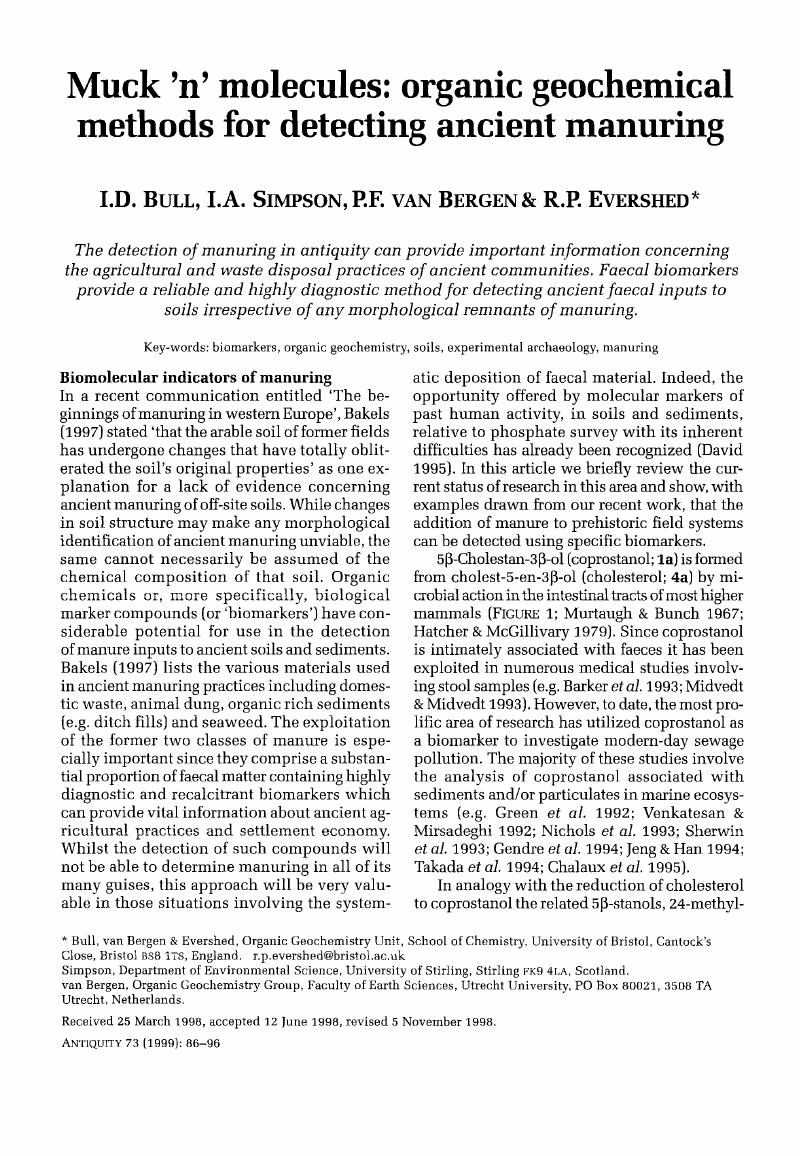Crossref Citations
This article has been cited by the following publications. This list is generated based on data provided by Crossref.
Jones, M. K.
Briggs, D. E. G.
Eglington, G.
Hagelberg, E.
Evershed, Richard P.
Dudd, Stephanie N.
Charters, Stephanieation
Mottram, Hazel
Stott, Andrew W.
Raven, Anthony
van Bergen, Pim F.
and
Bland, Helen A.
1999.
Lipids as carriers of anthropogenic signals from prehistory.
Philosophical Transactions of the Royal Society of London. Series B: Biological Sciences,
Vol. 354,
Issue. 1379,
p.
19.
Bull, Ian D.
Simpson, Ian A.
Dockrill, Stephen J.
and
Evershed, Richard P.
1999.
Organic geochemical evidence for the origin of ancient anthropogenic soil deposits at Tofts Ness, Sanday, Orkney.
Organic Geochemistry,
Vol. 30,
Issue. 7,
p.
535.
Simpson, I. A.
Bol, R.
Bull, I. D.
Evershed, R. P.
Petzke, K.-J.
and
Dockrill, S. J.
1999.
Interpreting early land management through compound specific stable isotope analyses of archaeological soils.
Rapid Communications in Mass Spectrometry,
Vol. 13,
Issue. 13,
p.
1315.
Bull, Ian D.
Bergen, Pim F.van
Nott, Chris J.
Poulton, Paul R.
and
Evershed, Richard P.
2000.
Organic geochemical studies of soils from the Rothamsted classical experiments—V. The fate of lipids in different long-term experiments.
Organic Geochemistry,
Vol. 31,
Issue. 5,
p.
389.
Briggs, Derek E. G.
Evershed, Richard P.
and
Lockheart, Matthew J.
2000.
The biomolecular paleontology of continental fossils.
Paleobiology,
Vol. 26,
Issue. S4,
p.
169.
Briggs, Derek E. G.
Evershed, Richard P.
and
Lockheart, Matthew J.
2000.
The biomolecular paleontology of continental fossils.
Paleobiology,
Vol. 26,
Issue. sp4,
p.
169.
Pollard, A. Mark
and
Heron, Carl
2000.
Encyclopedia of Analytical Chemistry.
Bull, Ian D.
Evershed, Richard P.
and
Betancourt, Phillip P.
2001.
An organic geochemical investigation of the practice of manuring at a Minoan site on Pseira Island, Crete.
Geoarchaeology,
Vol. 16,
Issue. 2,
p.
223.
Bull, Ian D.
Lockheart, Matthew J.
Elhmmali, Mohamed M.
Roberts, David J.
and
Evershed, Richard P.
2002.
The origin of faeces by means of biomarker detection.
Environment International,
Vol. 27,
Issue. 8,
p.
647.
Bull, I. D.
Elhmmali, M. M.
Roberts, D. J.
and
Evershed, R. P.
2003.
The Application of Steroidal Biomarkers to Track the Abandonment of a Roman Wastewater Course at the Agora (Athens, Greece)*.
Archaeometry,
Vol. 45,
Issue. 1,
p.
149.
Spoto, Giuseppe
2003.
Kirk-Othmer Encyclopedia of Chemical Technology.
Shahack-Gross, Ruth
Marshall, Fiona
and
Weiner, Steve
2003.
Geo-Ethnoarchaeology of Pastoral Sites: The Identification of Livestock Enclosures in Abandoned Maasai Settlements.
Journal of Archaeological Science,
Vol. 30,
Issue. 4,
p.
439.
Peters, K. E.
Walters, C. C.
and
Moldowan, J. M.
2004.
The Biomarker Guide.
Guttmann, EBA
2005.
Midden cultivation in prehistoric Britain: arable crops in gardens.
World Archaeology,
Vol. 37,
Issue. 2,
p.
224.
van der Veen, Marijke
2005.
Gardens and fields: the intensity and scale of food production.
World Archaeology,
Vol. 37,
Issue. 2,
p.
157.
Dahlin, Bruce H.
Beach, Timothy
Luzzadder-Beach, Sheryl
Hixson, David
Hutson, Scott
Magnoni, Aline
Mansell, Eugenia
and
Mazeau, Daniel E.
2005.
RECONSTRUCTING AGRICULTURAL SELF-SUFFICIENCY AT CHUNCHUCMIL, YUCATAN, MEXICO.
Ancient Mesoamerica,
Vol. 16,
Issue. 2,
p.
229.
Wells, E. C.
2006.
Cultural soilscapes.
Geological Society, London, Special Publications,
Vol. 266,
Issue. 1,
p.
125.
Hutson, Scott R.
Stanton, Travis W.
Magnoni, Aline
Terry, Richard
and
Craner, Jason
2007.
Beyond the buildings: Formation processes of ancient Maya houselots and methods for the study of non-architectural space.
Journal of Anthropological Archaeology,
Vol. 26,
Issue. 3,
p.
442.
Bogaard, A.
Heaton, T.H.E.
Poulton, P.
and
Merbach, I.
2007.
The impact of manuring on nitrogen isotope ratios in cereals: archaeological implications for reconstruction of diet and crop management practices.
Journal of Archaeological Science,
Vol. 34,
Issue. 3,
p.
335.
van Geel, Bas
Aptroot, André
Baittinger, Claudia
Birks, Hilary H.
Bull, Ian D.
Cross, Hugh B.
Evershed, Richard P.
Gravendeel, Barbara
Kompanje, Erwin J.O.
Kuperus, Peter
Mol, Dick
Nierop, Klaas G.J.
Pals, Jan Peter
Tikhonov, Alexei N.
van Reenen, Guido
and
van Tienderen, Peter H.
2008.
The Ecological implications of a Yakutian mammoth's last meal.
Quaternary Research,
Vol. 69,
Issue. 03,
p.
361.



